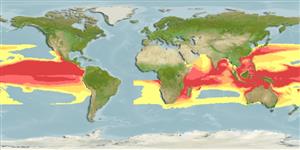Teleostei (teleosts) >
Beloniformes (Needle fishes) >
Exocoetidae (Flyingfishes)
Etymology: Prognichthys: Taken from Progne, name of Philomela´s sister, transformed into a swallow in the Greek mithology + Greek, ichthys = fish (Ref. 45335).
Environment: milieu / climate zone / depth range / distribution range
Ecology
Marine; pelagic-oceanic; oceanodromous (Ref. 51243); depth range 0 - 20 m. Tropical
Indo-Pacific: East Africa to Samoa. Eastern Central Pacific: off the coast of Central America (Ref. 9033). Not occurring in the Red Sea, Arabian Sea and the Persian Gulf. Probably absent in inland seas of southeast Asia.
Size / Weight / Age
Maturity: Lm ? range ? - ? cm
Max length : 19.0 cm SL male/unsexed; (Ref. 9839)
Found in oceanic surface waters. Leaps out of the water and glides for considerable distances above the surface.
Life cycle and mating behavior
Maturities | Reproduction | Spawnings | Egg(s) | Fecundities | Larvae
Parin, N.V., 1996. On the species composition of flying fishes (Exocoetidae) in the West-Central part of tropical Pacific. J. Ichthyol. 36(5):357-364. (Ref. 27313)
IUCN Red List Status (Ref. 130435)
Threat to humans
Harmless
Human uses
Fisheries: of no interest
Tools
Special reports
Download XML
Internet sources
Estimates based on models
Preferred temperature (Ref.
123201): 22.9 - 29.2, mean 27.4 °C (based on 39003 cells).
Phylogenetic diversity index (Ref.
82804): PD
50 = 0.5156 [Uniqueness, from 0.5 = low to 2.0 = high].
Bayesian length-weight: a=0.00646 (0.00292 - 0.01429), b=3.04 (2.84 - 3.24), in cm total length, based on LWR estimates for this (Sub)family-body shape (Ref.
93245).
Trophic level (Ref.
69278): 3.1 ±0.21 se; based on food items.
Resilience (Ref.
120179): High, minimum population doubling time less than 15 months (Preliminary K or Fecundity.).
Fishing Vulnerability (Ref.
59153): Low vulnerability (13 of 100).
